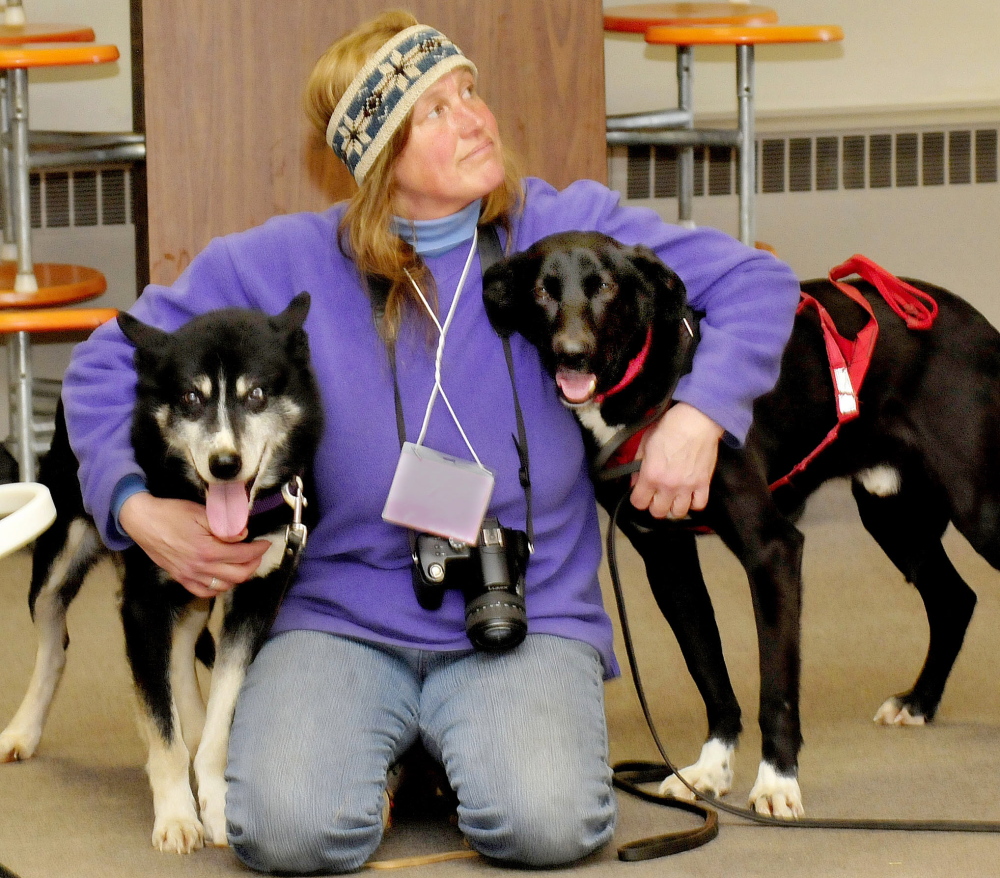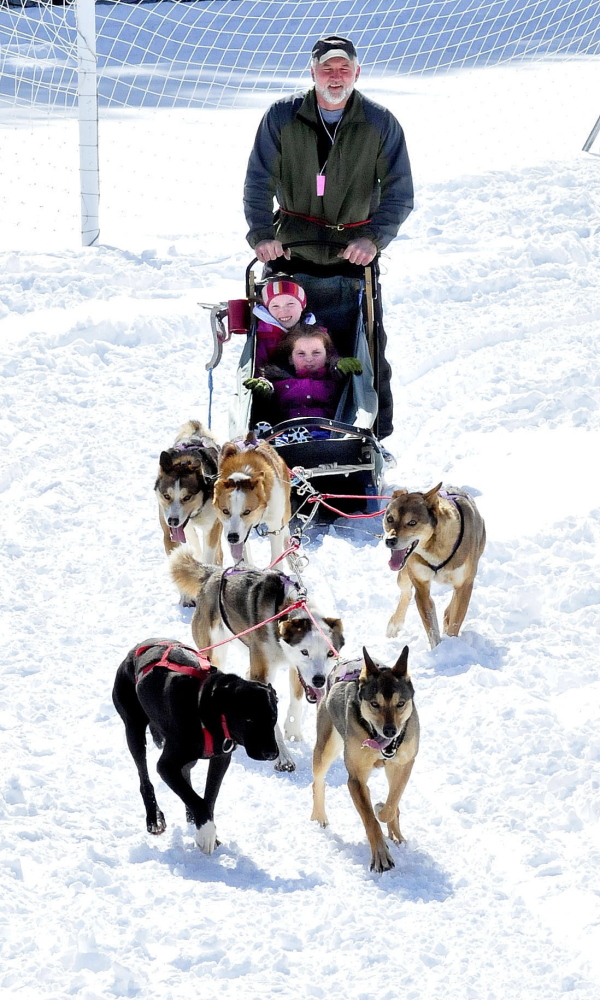CORNVILLE — It was hard to tell who was having more fun Monday — students at the Cornville Regional Charter School or the sled dogs that took them for rides on the snow behind the school.
The kids grinned and laughed. The dogs yipped and howled.
It all was part of an integrated learning project for the charter school’s second-, third- and fourth-grade students centered around the ongoing Iditarod sled dog race in Alaska, which began March 5.
“It was so cool, I want to do it again,” Maddy Thorndike, a fourth-grader from Cornville, and Isabella Mullen, a third-grader from Cornville, said almost at the same time after getting off the sled pulled by six dogs and managed by Lindy Howe and Kevin Quist of Heywood Kennel in Augusta.
Cornville principal Travis Works said the project was the idea of teacher Melanie Immediato as part of the charter school’s mission of combining outdoor activities with indoor classroom work.
“I love it. I think that she does a really nice job at integrating it through the different content areas,” Works said. “It makes it more relevant and meaningful to the kids.”
Immediato said she and another teacher, Amanda Gallant, are using the Iditarod as the foundation for teaching science, math, reading, social studies, technology and writing.
There is a chart on the wall with graphs showing the age of the mushers — the sled dog drivers. Two participants are in their 70s this year, five in their 60s and one is 18 years old. The number is split roughly half men and half women, she said.
“They have a teacher on the trail who goes along with them and reports to the classrooms in an educational piece. We’ve Skyped with her,” Immediato said. “We’ve integrated technology. Each of the mushers has a GPS unit, and we go on and we see them on the trail.”
Immediato said the group has used non-fiction books about sled dogs and true story books about related topics such as Balto, the sled dog who led his team to Nome, Alaska, to deliver diphtheria medicine in 1925 to stem an outbreak of the disease.
Along the wall are biographies of all the mushers and a large map detailing the 979-mile, 10-day race with daily mile markers and check points.
“We’ve also done Google Earth to study science where we’ve been learning about the tundra,” she said. “We also check the standings every day. Each group in partners has a musher that they’re following. It’s a high interest topic, and we’ve been able to integrate all the different curriculum areas into it.”
By late afternoon Eastern time, Monday, Aaron Burnmeister had overtaken Dallas Seavey for the lead.
Two of the estimated 30 students involved in the project said they like the work and already have learned a lot.
Bryce Jewell, a third grader from Skowhegan, said he is interested in the Iditarod and would like to train a sled dog himself.
“I like dog sled racing,” he said. “I want to start my own team. My grandfather (Dennis Jewell of Cornville) has a dog sled and a harness, and I’m going to start training my puppy to do it. I like the Iditarod. I’m watching it on the computer.”
Ava Goucher, a second grader from Canaan, said she likes learning about sled dogs and the Iditarod.
“It’s something you can learn about, and I like having the opportunity to learn about it because I’ve never known about it before,” she said. “I think it’s pretty cool — dog sledding — I like almost everything about it.”
The sled dog rides on the snow-covered soccer field were preceded by a brief presentation in the school gym, where Howe and Quist, both registered Maine guides, spoke of their lives, their dogs, their love of dog sledding and the work that goes into training the dogs and learning how to manage them.
“Dog sledding is a true team sport, and everybody has to do their share,” Quist said.
The dogs are mostly Alaskan husky with Beckett, who appeared with them in the presentation Monday, a mix of German shorthair pointer.
Quist said they gave Beckett away as a puppy to a neighbor, noting that if they couldn’t handle the dog, they could bring him back. The little dog had been smaller than his brothers and sisters, bow-legged, flat-footed and “a little bit whiny,” he said.
The other family brought him back and soon Beckett — from the Red Sox litter, Quist said — was running with the big dogs, ultimately becoming one of the kennel’s best lead dogs. Beckett was joined in the presentation by Old Joe, a handsome Alaskan husky who helps mentor and teach the younger dogs.
Doug Harlow — 612-2367
Twitter: @Doug_Harlow
Send questions/comments to the editors.





Success. Please wait for the page to reload. If the page does not reload within 5 seconds, please refresh the page.
Enter your email and password to access comments.
Hi, to comment on stories you must . This profile is in addition to your subscription and website login.
Already have a commenting profile? .
Invalid username/password.
Please check your email to confirm and complete your registration.
Only subscribers are eligible to post comments. Please subscribe or login first for digital access. Here’s why.
Use the form below to reset your password. When you've submitted your account email, we will send an email with a reset code.